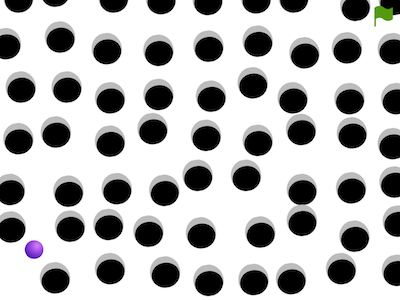In thinking about developing an app for NetsBlox, a block-based programming language that introduces coding to young learners, Devin Cruz Jean asked himself a simple question:
Would he, as a middle school or early high school student, be interested in the data sets NetsBlox could access?
The answer was no. “I would not be interested in this as a kid,” said Devin Jean, a second-year computer science graduate student. “You can pull all this data, but you cannot interact with it. The key is being able to interact with the data.”
So, he made interaction easy, and the mobile app he developed has won Best Showcase Award from an influential international research forum.

The app, called PhoneIoT, connects to NetsBlox and introduces the Internet of Things, IoT, in the classroom, giving users access to all the sensors on an iOS or Android mobile device. Devin’s goal was to address barriers that have made it difficult to include some of the most ubiquitous contemporary computing concepts—Internet of Things, Cyber Physical Systems, networked sensing, and actuation—in K-12 computer science and engineering education.
The award is from the 2021 IEEE Symposium on Visual Languages and Human-Centric Computing. The organization is the premier international forum for research on the design, theory, application, and evaluation of computing technologies and languages that are easier to learn, use, and understand.
“NetsBlox and PhoneIoT make computer education much more engaging, motivating and interesting,” said Brian Broll, research scientist at the Institute for Software Integrated Systems. “The block-based interface allows students to write distributed programs, programs that run on multiple computers or devices, in a way that abstracts away most of the underlying complexity while still allowing students to learn the most important concepts,” he said.

Teaching the Internet of Things requires the purchase of sensors and other gadgets, assembling them, and connecting them to the internet. Fun, yes, but not in the budgets of most schools. However, 90 percent of students already have a phone in their pocket that is connected to the internet and filled with sensors, Broll said. PhoneIoT makes them available for their NetsBlox programs.
With the app, students use NetsBlox to communicate with the device and retrieve live sensor data. What that means is the ability to create tilting controls for a game with the phone’s accelerometer or device tracking capability with the phone’s location data, as two examples. Also, students can add labels, buttons, joysticks, and image displays as controls on the customizable screen and write the code that responds to user interface actions.
At a two-week summer camp in 2021, students using NetsBlox and PhoneIoT not only programmed virtual robots with NetsBlox but also turned their phones into custom remote controls for them and competed in a virtual race. Few of the participants had any prior programming experience.
Devin Jean, who graduated with a B.S. in computer science from Middle Tennessee State University in 2020, started programming early, with Roblox, a free game development platform in which users create their own avatars and games and can join games created by others. An estimated two-thirds of U.S. kids ages 9 to 12 have accounts on Roblox, which combines aspects of programming, video games and social media.

“I always really liked technical things, games and automation,” he said.
NetsBlox, which introduces distributed computing, already allowed users to create simple multiplayer games like trivia contests and turn-based games like Tic Tac Toe they can play with each other or access publicly available data sets for science projects on earthquakes, astronomy, weather, or air pollution. Enabling access to phone sensor data was a natural extension, Devin said.
PhoneIoT has even made it into the Vanderbilt curriculum. In CS 1103, an introductory programming course using MATLAB, students spent the first two weeks of this semester learning programming with NetsBlox and creating projects with PhoneIoT.
Notable student projects included an asteroid shooting game controlled by the phone’s digital compass, a campus guide quiz in which users must recognize Vanderbilt buildings, and several drawing apps that allowed real-time computer display of what users scribbled on their phone.